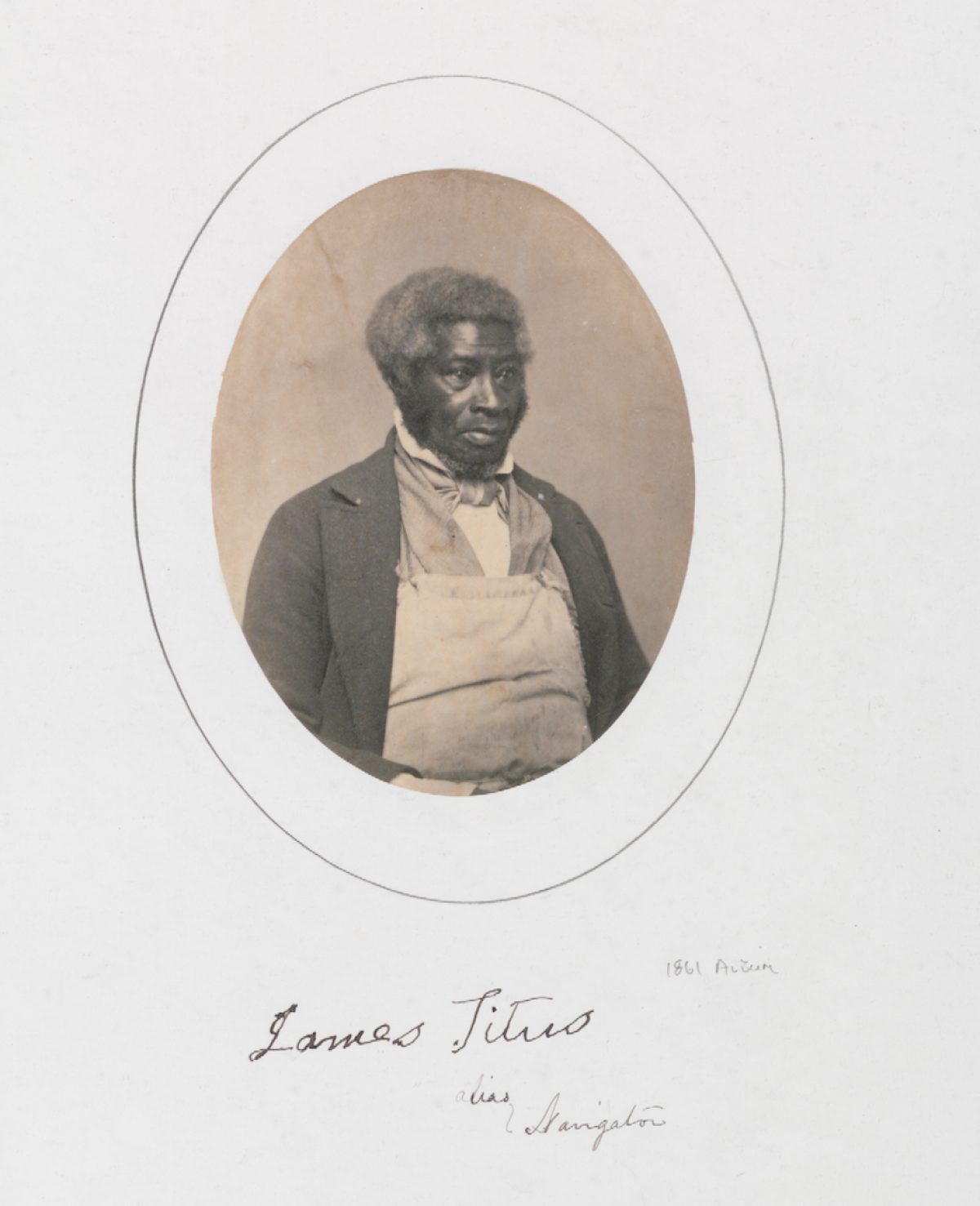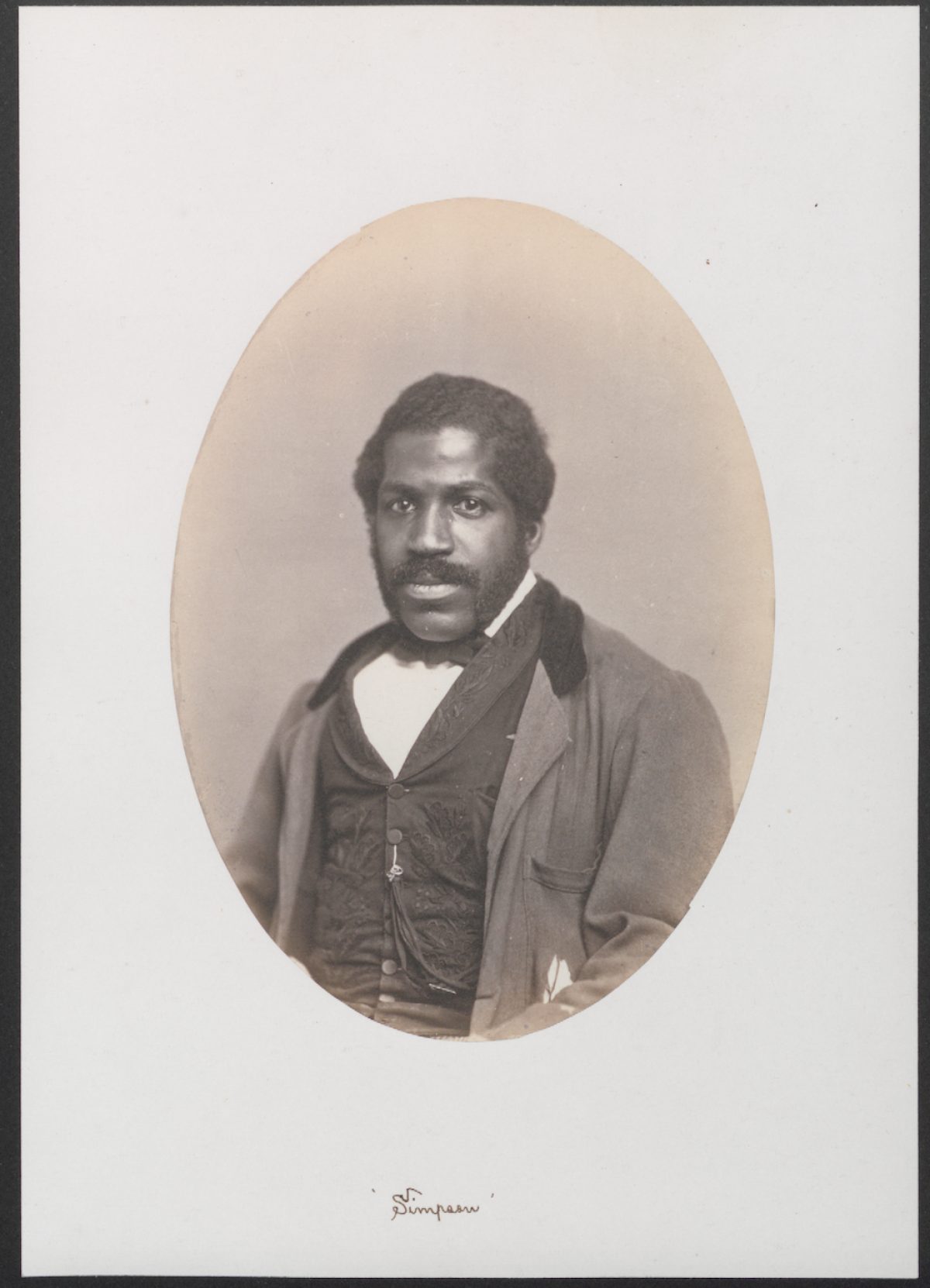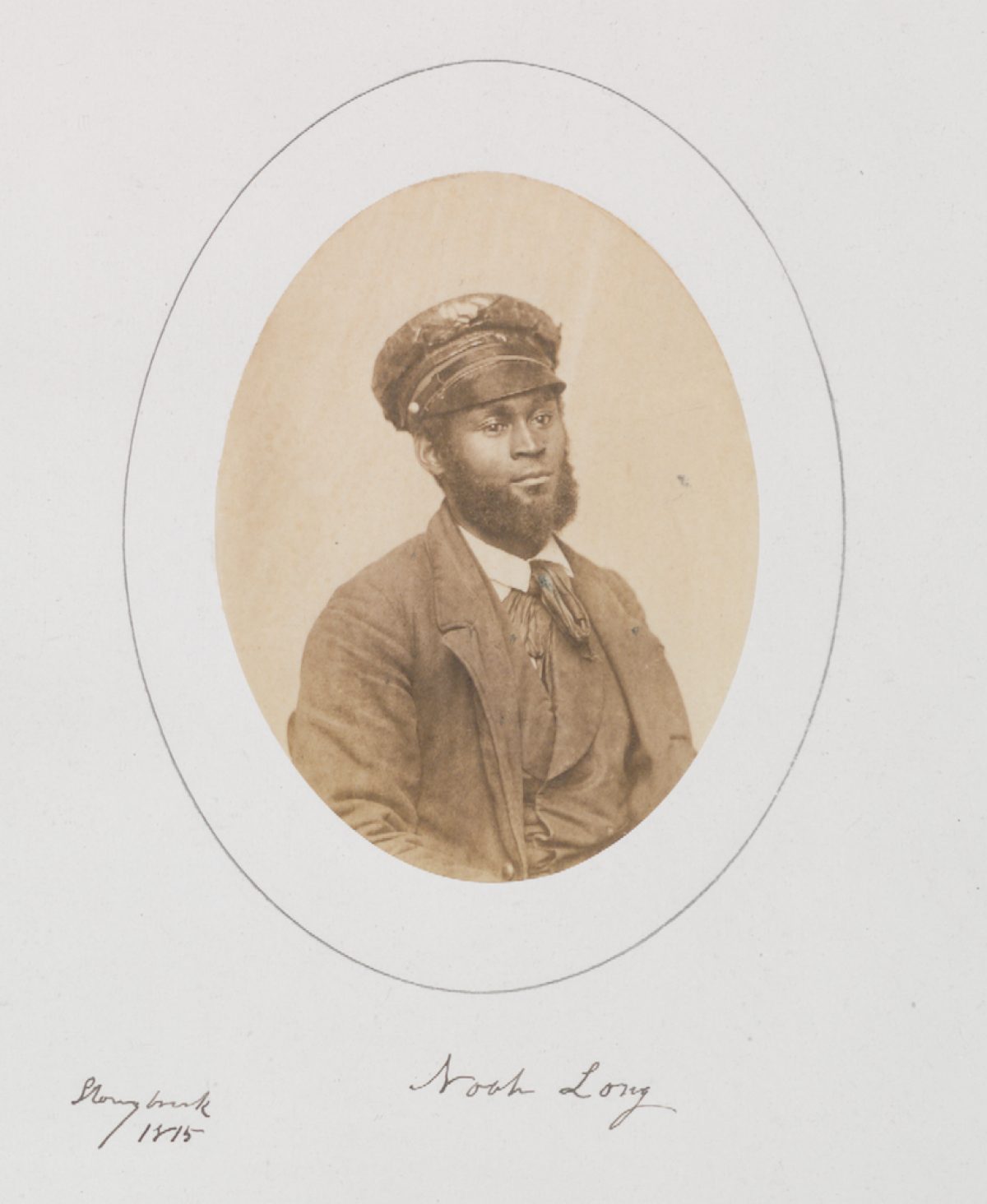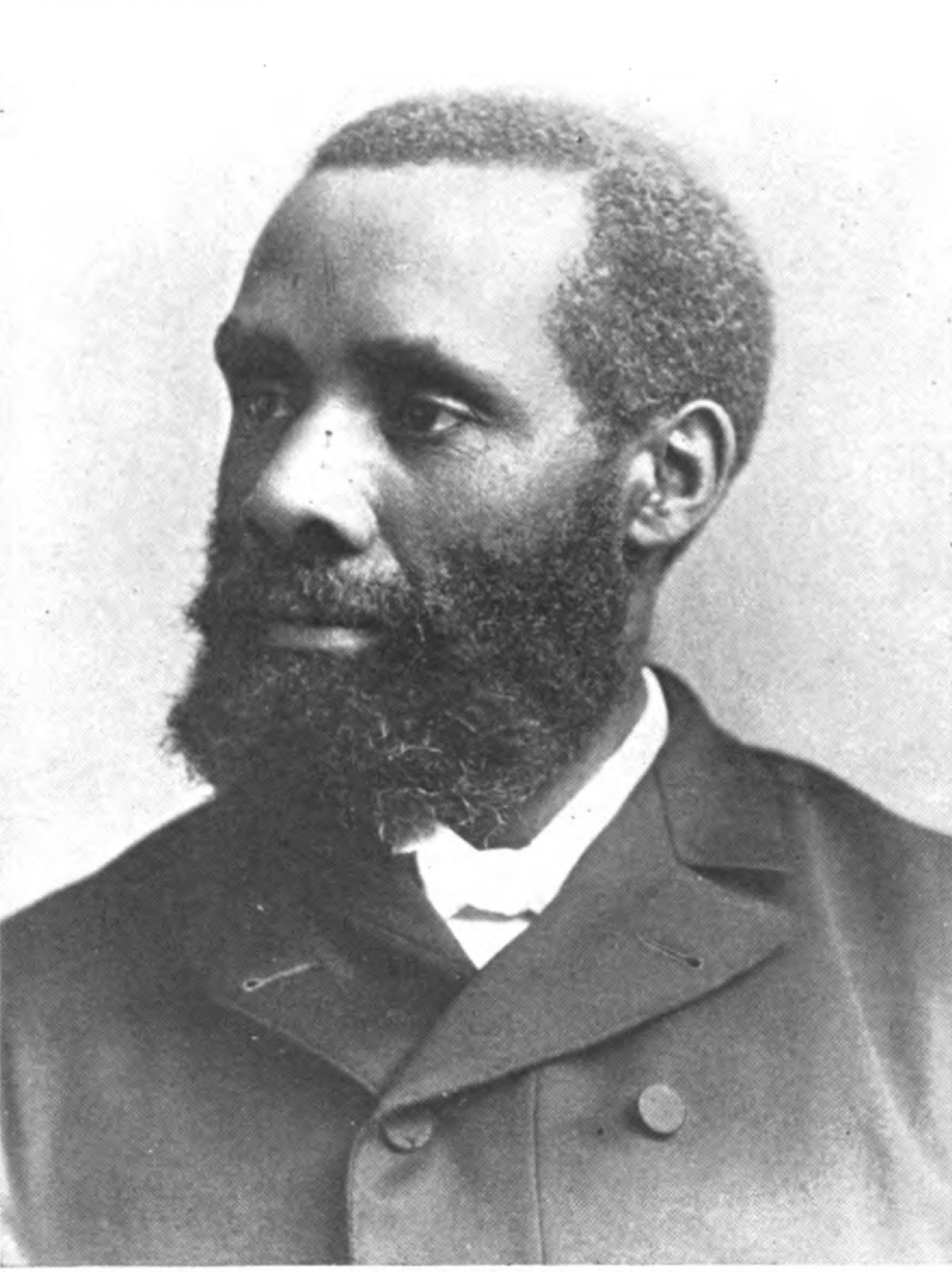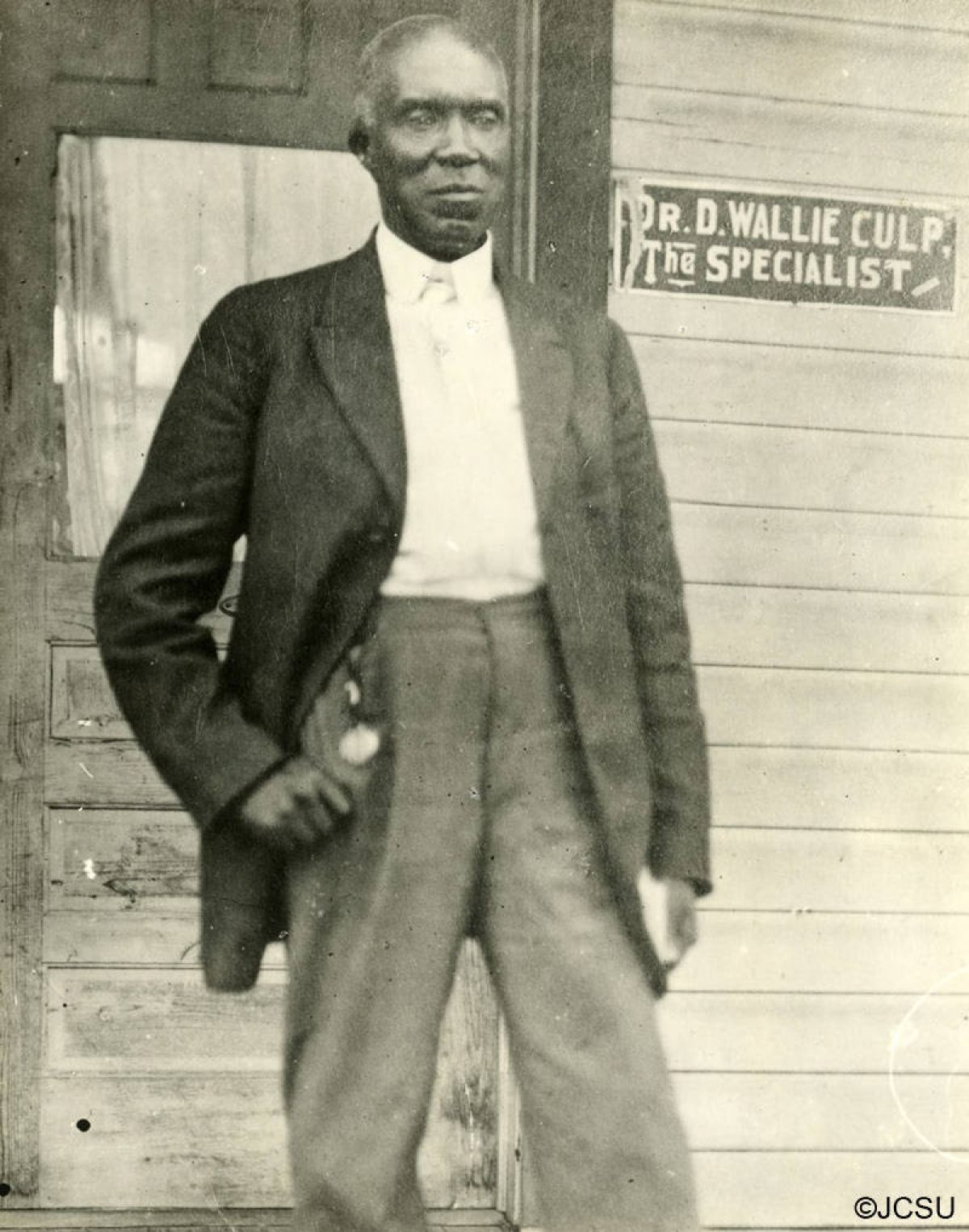Introduction
During its first two hundred years, Princeton University (then the College of New Jersey) was a segregated institution. Prior to the Civil War, as the school became increasingly dependent on money from southern slaveholders, its students, faculty, and administrators remained committed to white supremacy.
At the same time, African Americans were a constant presence on campus. Slaves lived and worked at the President’s House and were sold at auction within sight of Nassau Hall. Black residents of Princeton filled essential roles on campus as cooks, janitors, and servants. Others advanced the school’s educational mission as research and teaching assistants. Some black workers became minor celebrities and unofficial mascots, and they posed for photos for graduating seniors. A small number of former slaves studied on campus. Life for these pioneering laborers and scholars could be difficult, and they endured threats, ridicule, and physical violence. One Princeton resident later compared the school to a southern plantation.
This legacy of exploitation and abuse shaped the character of the institution for generations. Although several African American graduate students received degrees in the late-19th and early-20th centuries and Alexander Dumas Watkins, a black man, served as an instructor in the 1880s and '90s, unlike most of its peers, Princeton refused to admit undergraduates of African descent until the middle of the 20th century.
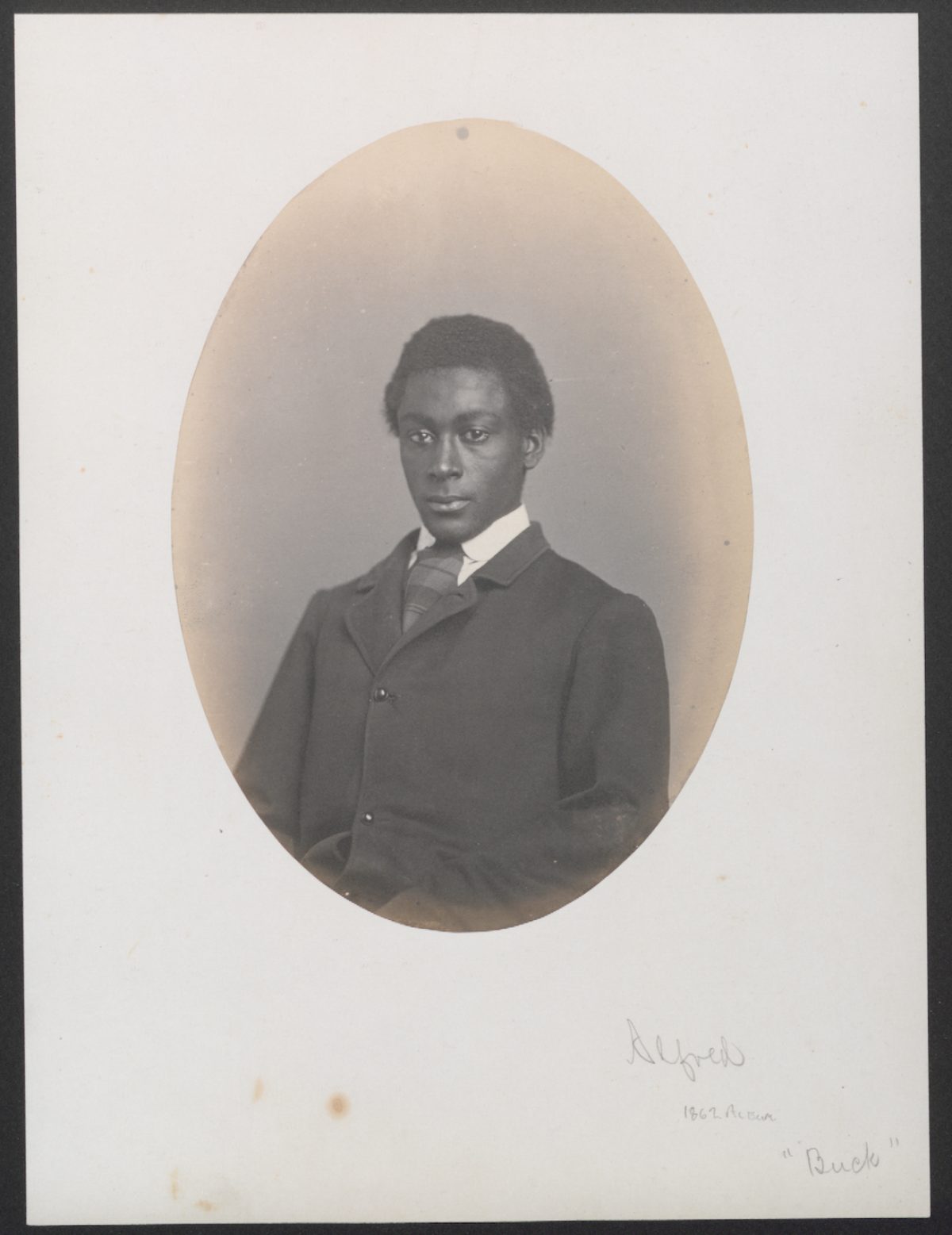
Photo of Alfred Scudder, assistant to Professors Stephen Alexander and John Schanck, and janitor of Clio Hall.
View Primary Sources
Slaves, Servants, and Entrepreneurs
Enslaved men and women were present at the College of New Jersey from its very beginning. The first nine presidents of the college all owned slaves. An enslaved family consisting of two women, a man, and three children, lived and worked at the President’s House during the 1760s, and enslaved people continued to live there into the 19th century. Students and other guests arriving at the house to take exams or to conduct business would have encountered these individuals on intimate terms.
Slavery was everywhere in town, surrounding and permeating the school. Slaves worked on farms, drove carriages and sleds, cooked meals, and washed clothes. When Nassau Hall burned to the ground in 1802, destroying most of the college library and causing thousands of dollars’ worth of damage, Princeton residents suspected that a rebellious slave lit the blaze. An individual identified only as “Findley’s Negroe boy” was captured after setting two other fires in the vicinity. His owner may have been Robert Finley (class of 1787), a tutor and later trustee of the college.[1]

Richard Stockton submitted this account to the Trustees of the College of New Jersey after hiring out a man named Cesar to the college for unspecified work. Although Princeton as an institution never owned enslaved people, if the Cesar named here was an enslaved man, this document shows that the college did engage enslaved laborers for work on campus.
View Primary Sources

A letter from Joseph Olden to Mary Middleton, describing the destruction of Nassau Hall and the capture of an enslaved arsonist.
View Primary Sources
Prospect Farm, which stood directly behind Nassau Hall and now forms part of the central campus, exploited generations of enslaved laborers. Established in the 18th century, the farm included an apiary, a cattle herd, and a cherry orchard frequented by students. As late as 1830, at least one slave, a woman between 24 and 36 years old, resided on the property. Free black residents also worked for hire and lived on the farm through the 1840s. Princeton student Basil Gildersleeve (‘1849) reported that he had a close view of the Prospect farmhouse from his dorm room window, and like his predecessors he probably saw black men and women working there on a regular basis. Southern slaveholders generally felt at home in Princeton. An enslaved man named Sawney accompanied James Madison (‘1771) to Nassau Hall in 1769. Over eighty years later, according to family tradition, Charles Haile (‘1855) brought his slave valet Doby to campus. There is no evidence, however, that students kept their human property with them while the school was in session.[2]
The free black community that coalesced around Witherspoon Street, on the north side of Nassau Hall, supported itself in large part through work for the college. An unknown number of African Americans performed routine chores on campus. A list of responsibilities compiled in 1802 included lighting fires and providing water for students, shining their shoes, removing and replacing their dirty sheets, and sweeping their rooms. Some residents served as personal attendants for individual students. John Kyle (‘1852) wrote home about “a Black man” who cared for him while he was ill, cleaning him and removing his waste. Others found employment on campus as janitors, waiters, valets, wood choppers, cooks, and research assistants. The work was difficult and the pay was low. For some, the conditions seemed little better than slavery. Paul Robeson, who was born in town in 1898, described the situation at the turn of the century:
Almost every Negro in Princeton lived off the college and accepted the social status that went with it. We lived for all intents and purposes on a Southern plantation. And with no more dignity than that suggests—all the bowing and scraping to the drunken rich, all the vile names, all the Uncle Tomming to earn enough to lead miserable lives.[3]
A small number of black workers became well known on campus. Peter Scudder, known by the nickname “Peter Polite,” served Princeton students for nearly half a century. When not cleaning rooms or shining shoes, he ran a business selling pies and ice cream. A former slave, Scudder learned how to read and gained “religious instruction” from his student clients after hours. James Titus served as a bootblack and messenger for the university, and signed his name in graduates’ autograph books. “Aunt” Clara Voorhees, born into slavery in the 1790s, served in a number of local families prior to her emancipation at the age of twenty-five. According to one report, she worked for the family of President Ashbel Green, although it is unclear whether she was enslaved at the time. After obtaining her freedom, Voorhees labored as a chef at the college for over three decades and became famous for her elaborate commencement dinners. Her death, in January 1892, was momentous enough to warrant an obituary in the New York Times.[4]
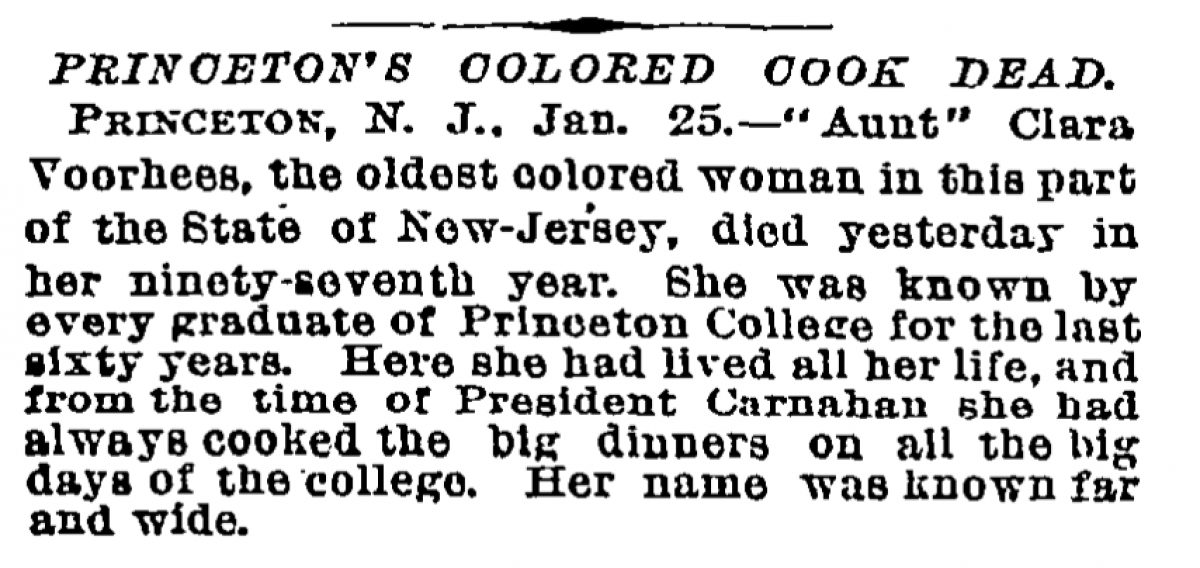
New York Times obituary for Clara Voorhees, a former slave and longtime chef at Princeton.
View Primary Sources
A free black man named Sam Parker served as a research assistant for Professor Joseph Henry for six years, providing crucial support for his scientific experiments. Professor Henry also used Parker as a teaching aid, letting students run electrical current through his body. Parker developed a side business dealing in used clothes, and showed pride in his wardrobe by modeling his vast collection of suits around campus.
James Collins Johnson, who escaped from slavery in Maryland and settled in Princeton, became something of a celebrity after his arrest, trial, and manumission. Beginning as a janitor, he held a variety of jobs at the college. Like Scudder and Parker, he soon established his own business selling used clothing and furniture to students. Eventually this evolved into a full-time position vending fruit and other snacks at major events. A series of black men followed Johnson’s example, working as campus vendors until the middle of the 20th century.[5]
During the years leading up to the Civil War, a few workers began posing for photographs. A small number of these remain in souvenir albums in the Princeton University Archives. Like the portraits of students and faculty produced during the same period, they were keepsakes and mementos of life on campus, similar to the photographs in modern yearbooks. In one photo, James Titus, an elderly man with white hair, is labeled “navigator.” In another photo, a young man identified as “Noah Long” sports a weathered cap and visor. Alfred Scudder, who worked for Chemistry and Zoology Professor John Schanck, sits confidently with arms folded. Below his image, he is listed as “Assistant Professor of Natural Philosophy.” Though the inscription is tongue-in-cheek, it hints at the central role that black laborers played in the day-to-day educational activities of the college. Like Sam Parker, Scudder probably assisted with scientific experiments and participated in classroom instruction.[6]
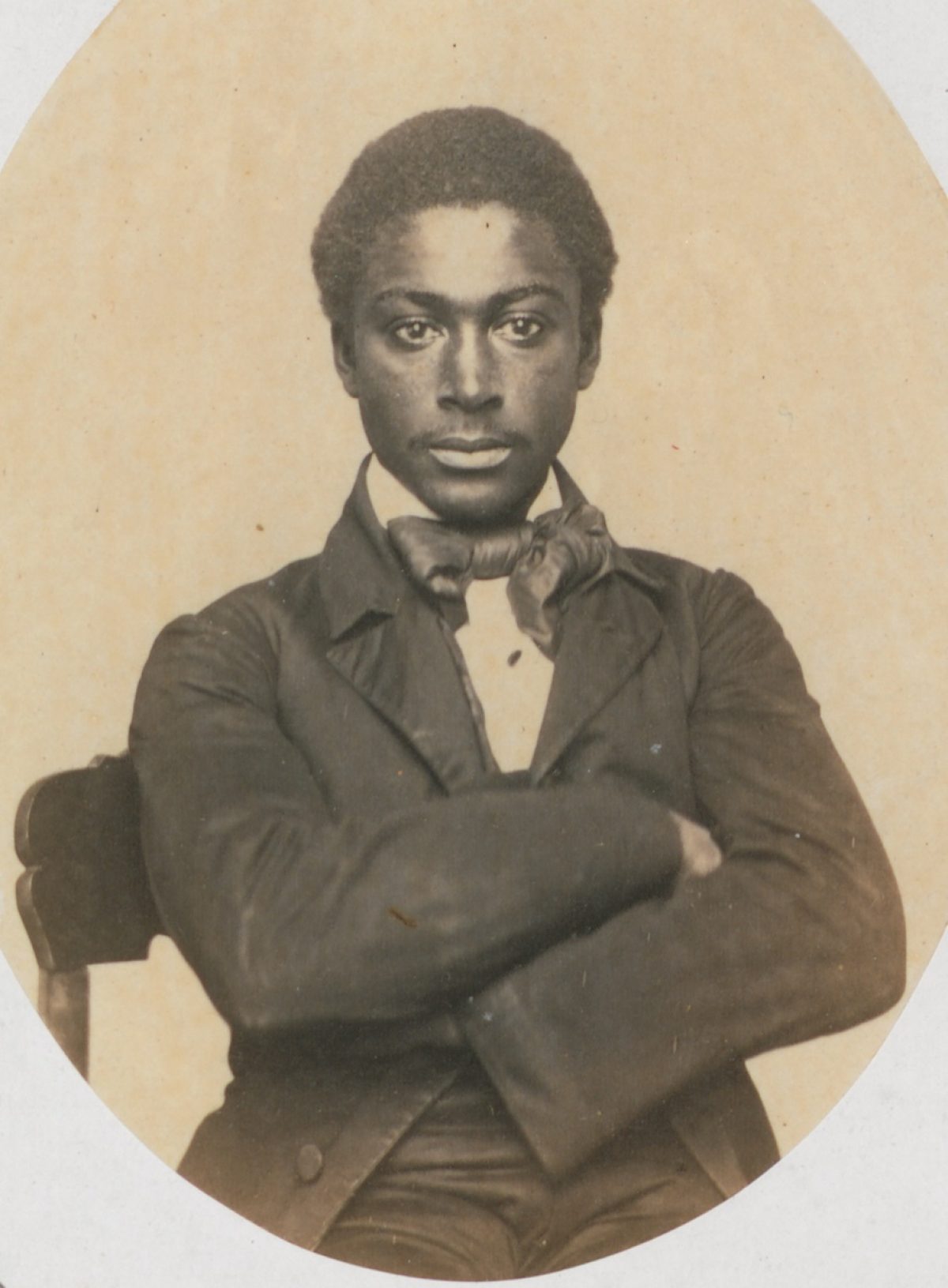
Alfred Scudder, Assistant Professor of Natural Philosophy, from a student photo album.
View Primary Sources
Even these relatively privileged workers experienced difficult conditions. Students resented Parker’s entrepreneurial activities and considered him “impudent.” At least one New Jersey student beat him severely. Johnson, who suffered from a bad stutter, was a popular target for caricature. A cartoon published on campus showed him diving into an outhouse to retrieve lost property for a student. Called “Jim Stink” in reference to his latrine duties, he became an unofficial mascot, both celebrated and demeaned by his customers.
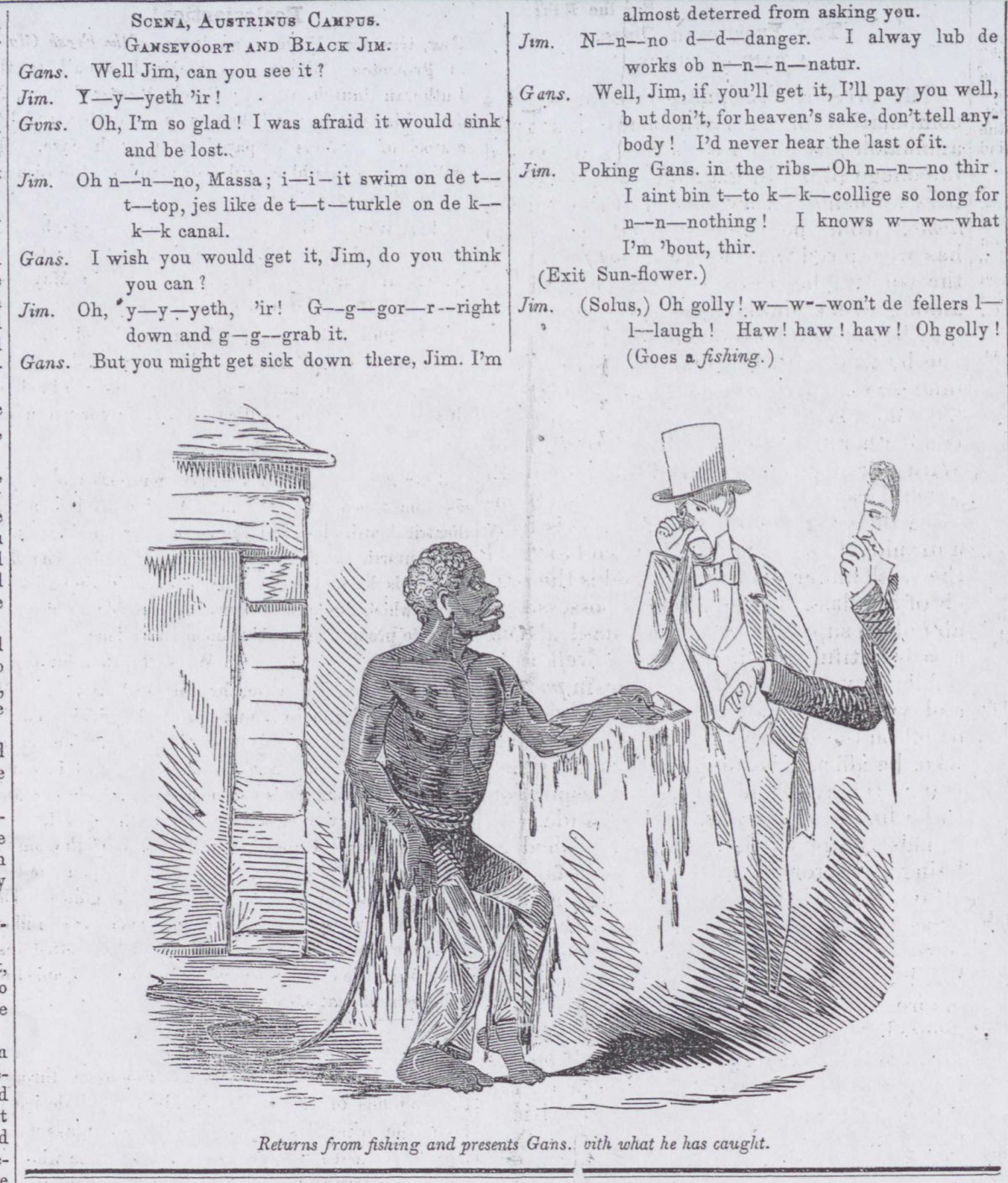
A dialogue between James Collins Johnson and Henry Sanford Gansevoort (class of 1855).
View Primary Sources
As long as they remained subordinate, both economically and socially, black workers could usually avoid violence. But not always. Tennessean Andrew Jackson Polk (‘1844) encountered a black man in his room on the third floor of Nassau Hall. Assuming the man to be a thief, Polk forced him downstairs and threw him out of a nearby window. According to John Sherrill (‘1866), a group of southern students placed an apple “on the head of a colored lad who was with them as a servant” and attempted to shoot it with a pistol.[7]
Black women, who endured the double oppression of racism and sexism, played a less visible role at Princeton. In the highly charged, all-male world of the undergraduates, women of any kind were rare and mysterious. Although difficult to piece together, evidence suggests that black women garnered special attention. An editorial cartoon published in the Nassau Rake in 1853 depicts two southern students leering suggestively behind a dark-skinned woman on a local street. “I’ll be darned if there ain’t some right good looking niggar gals here, ain’t they?” one says to the other. The tone is indicative of the racist, sexualized banter that suffused the campus. At least one student diary hints at the existence of clandestine sexual liaisons across the color line. In June 1846, an alleged sexual assault against a black woman touched off a sprawling, day-long riot between southern students, the Vice President John Maclean Jr., and sundry others from the campus and the town. The incident ended when the students severely whipped the woman’s defender, an unnamed black male.[8]
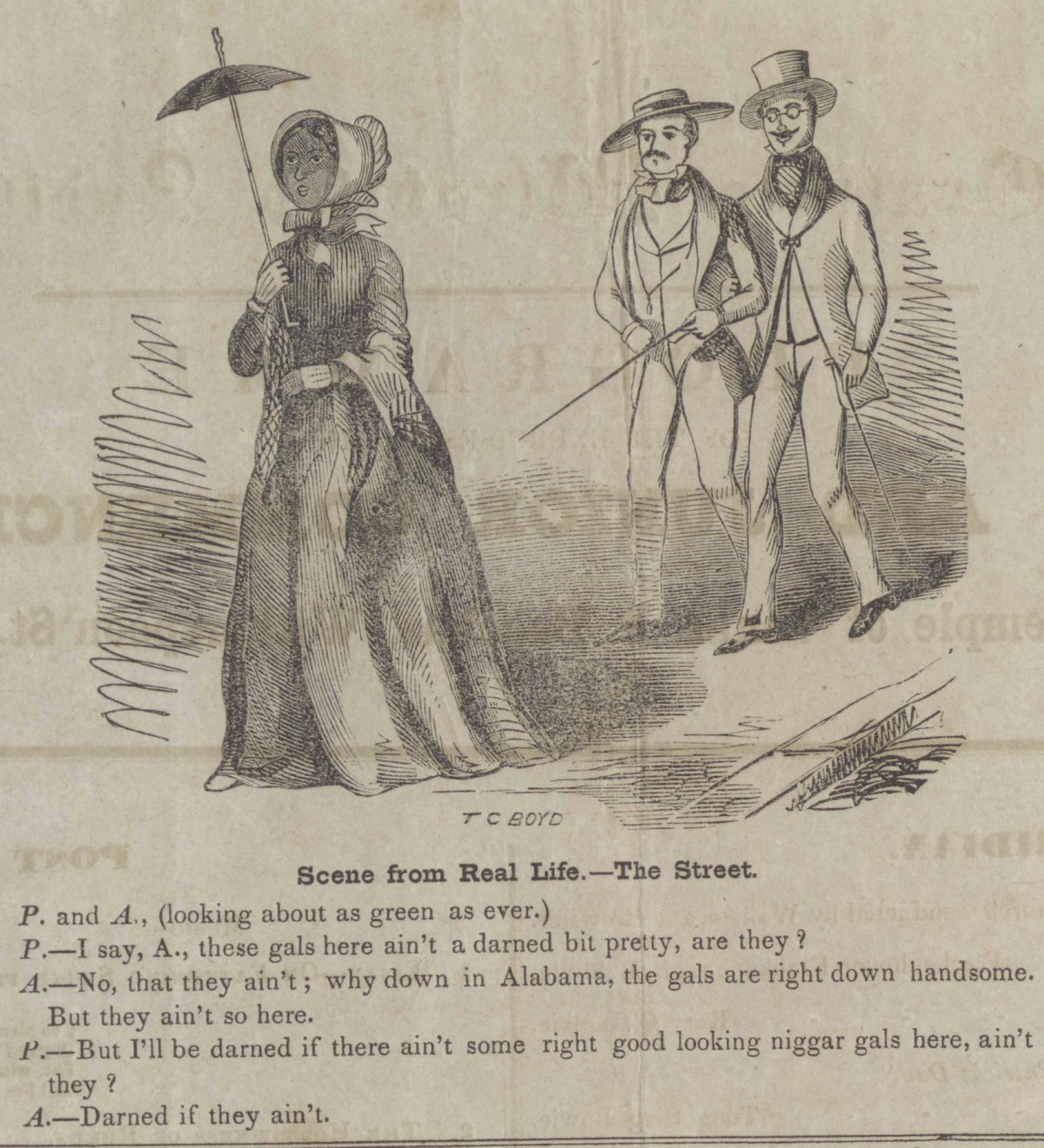
Cartoon from a student newspaper, The Nassau Rake, depicting two white men commenting on the attractiveness of black women in Princeton.
View Primary Sources
Early Black Students
For the small group of free and enslaved people of African descent living and working on campus, the college offered a daily reminder of everything that they were denied. In the exclusive white world of power, privilege, and higher education, they were both conspicuously present and deliberately ignored. It is reasonable to assume that these men and women informally audited classes as they moved about, performing their daily tasks. Some benefited from private tutorials with students and faculty. Betsey Stockton, born into slavery around 1798 and employed as a domestic servant by President Ashbel Green, developed a voracious appetite for knowledge. Assisted by Green, she became the first single female missionary to Hawaii, where she operated a successful school and trained indigenous teachers. Returning to Princeton in 1835, she taught at a segregated school for black children until her death in 1865.
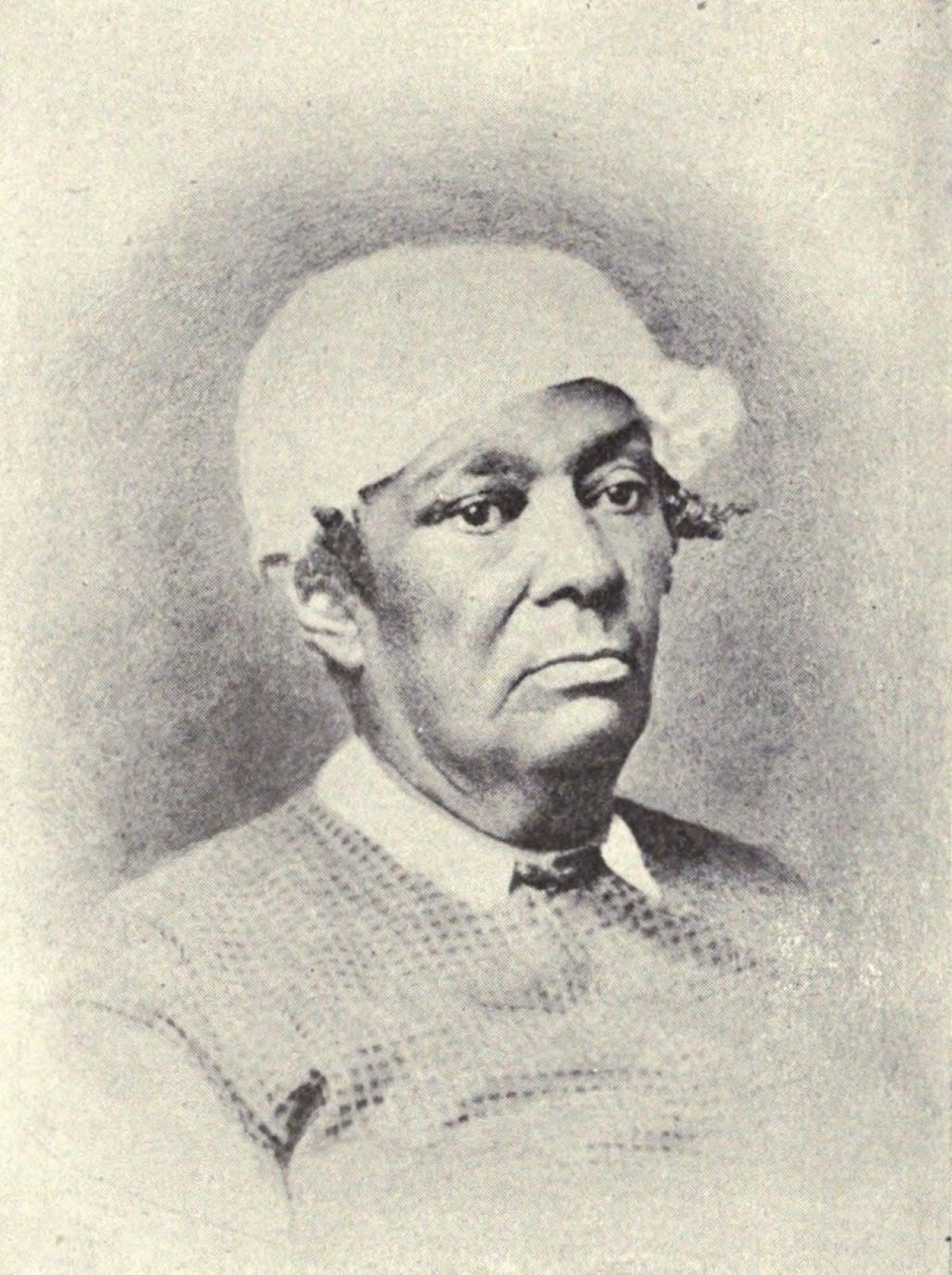
Photo of Betsey Stockton, former slave and servant of Princeton President Ashbel Green.
View Primary Sources
Bristol Yamma and John Quamine were the first black students to arrive on campus in an official capacity. Born in Africa and shipped from Anomabu, in what is now Ghana, both men were enslaved in Newport, Rhode Island. While there, they attracted the attention of local ministers, who hoped to train them as missionaries to their homeland in Africa. Through a combination of hard work, influential friends, and lottery winnings, the pair purchased their freedom by 1773. Following a prolonged transatlantic fundraising campaign, Yamma and Quamine departed for Princeton in November 1774. Although not enrolled as students for a degree, they attended private lessons with President John Witherspoon. Both men left families behind—Quamine’s wife remained a slave of Princeton graduate William Channing (‘1769). By February 1775, Witherspoon reported:
They are become pretty good in reading & writing & likewise have a pretty good Notion of the Principles of the Christian faith.
By the end of the winter, however, their funding had run dry and both made the journey back to Rhode Island. Their studies interrupted by the chaos of the American Revolution, neither returned to Africa.[9]
In September 1792, the Trustees of the College allocated funds for the education of John Chavis, “a free Black man” from Virginia. Apart from his service in the Revolutionary War, there is little information about his early life. Although he is not listed as an enrolled student on contemporary documents, family tradition and other evidence suggests that Chavis studied at Princeton, at least for a short time. He may have attended tutorials with President Witherspoon, similar to Yamma and Quamine. Records indicate that he also attended Liberty Hall Academy, the predecessor of Washington and Lee University, in Virginia. Whatever the case, Chavis followed a career path that was remarkably similar to many other 18th century Princeton graduates. Licensed as a Presbyterian minister in 1800, he established a popular school in Raleigh, North Carolina, where he taught both white and black students in segregated classes. Some of his students continued on to illustrious careers as politicians, lawyers, ministers, and teachers.[10]
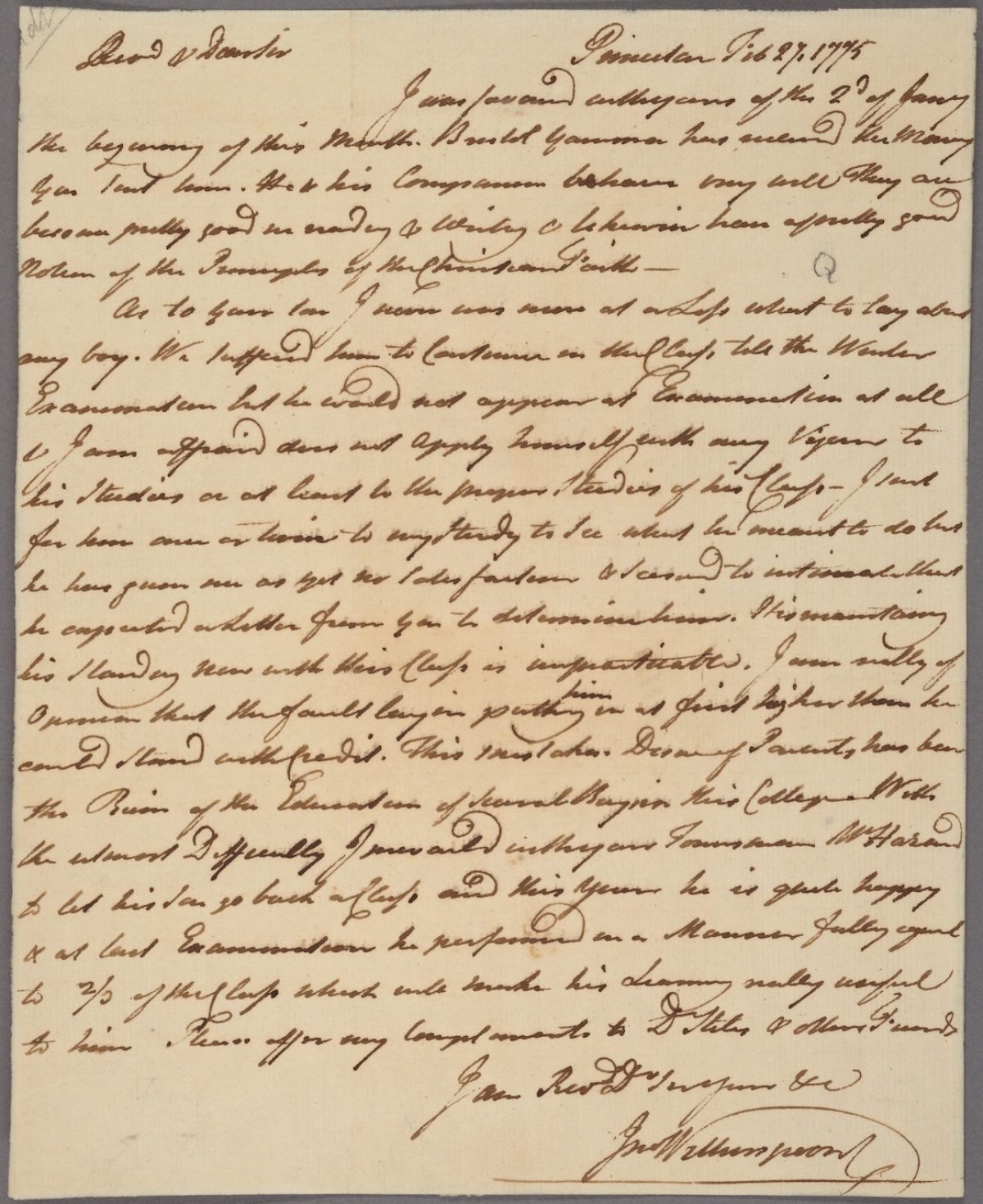
Letter from John Witherspoon to Samuel Hopkins, describing the progress of students Bristol Yamma and John Quamine.
View Primary Sources
When Theodore S. Wright arrived at Princeton in 1825, he was the first black scholar to set foot on campus in at least three decades. Born in New Jersey in 1797, he attended the renowned African Free School in New York City and applied to several colleges before gaining admission to the Princeton Theological Seminary. Although technically separate from the College of New Jersey, the two institutions had significant ties. Seminarians audited classes at the college, undergraduates attended events at the seminary, and faculty and staff moved freely between their grounds. Ashbel Green, Princeton’s eighth president, served concurrently as the President of the Board of Trustees for the seminary. Still, there were important distinctions. The schools had different academic administrations, different curricula, and different students. Following an undergraduate-led attack against an abolitionist in 1835, college officials refused a donation of $1,000 to educate students "irrespective of color."[11]
The difference between the college and the seminary became apparent in September 1836, when Wright returned to Princeton to visit friends and attend the annual commencement. At the end of the ceremony, held in the seminary chapel, undergraduate Thomas Ancrum (‘1838) physically assaulted Wright. Shouting “‘Out with the nigger’ — ‘Out with the nigger’,” Ancrum grabbed the minister by the collar and kicked him several times before being restrained. In the aftermath of the assault, Wright was careful to distinguish between the college and the seminary, expressing his preference for the latter. As he wrote in an open letter:
I cherish feelings of profound respect and affection for my ‘Alma Mater.’ I always feel, when at Princeton, that I am in the midst of fathers and brethren, in the holy and responsible work to which we are devoted.
Meanwhile, President James Carnahan’s attempt to dismiss the incident, and the tacit support of the faculty and undergraduates, exposed the racist foundations of the College of New Jersey.[12]
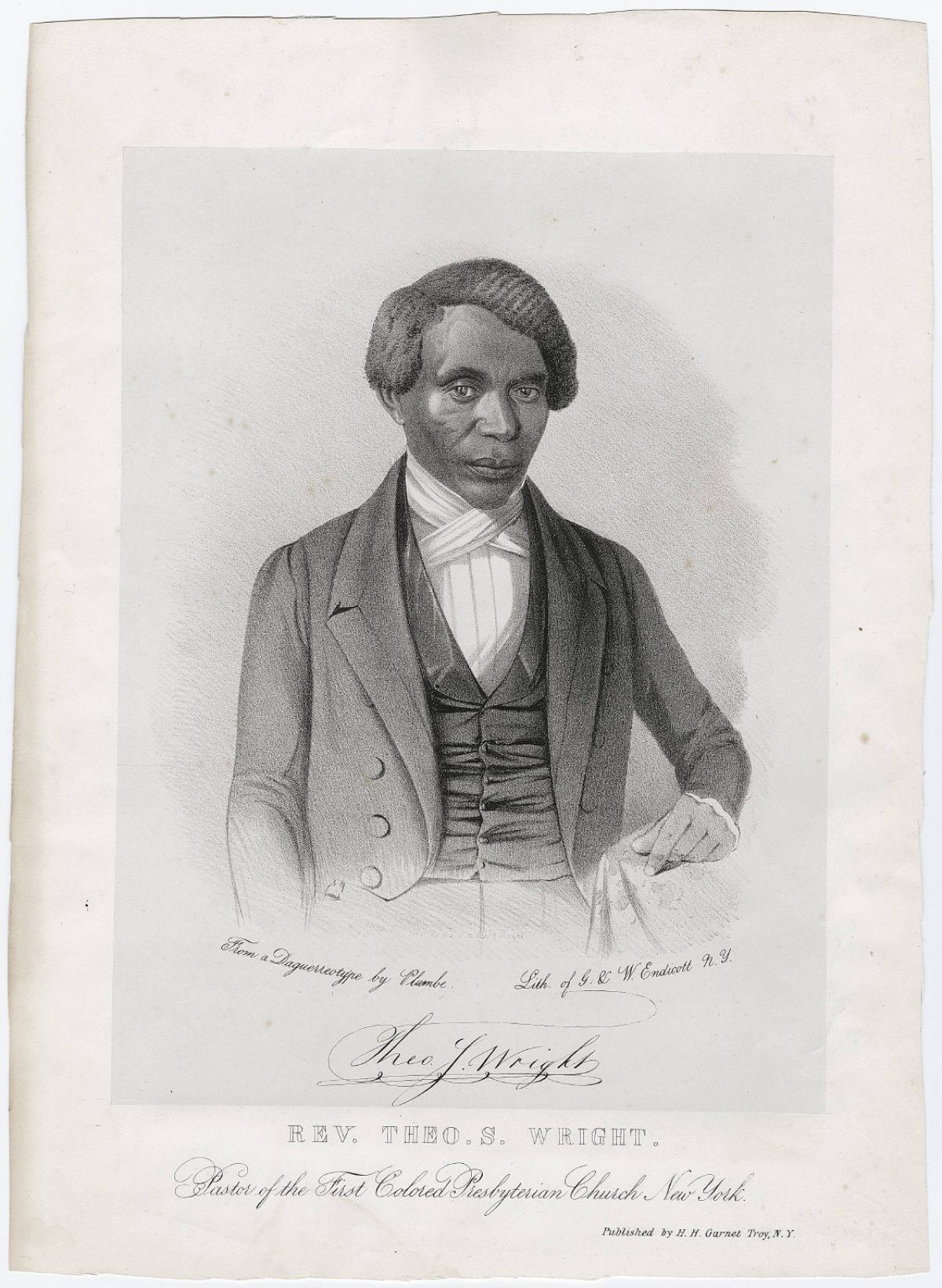
Lithograph portrait of the Rev. Theodore Sedgwick Wright, Princeton Seminary class of 1828.
View Primary Sources
When Theodore Wright graduated from the seminary in 1828, he became the first African American in the United States to complete a course in theology. Over the next few years, he achieved prominence as the pastor of the First Colored Presbyterian Church in New York City and served as a founding member and leader of the American Anti-Slavery Society. Black seminary student Henry M. Wilson followed in Wright’s footsteps two decades later. Graduating in 1848, Wilson also served as a minister in New York and became a successful community organizer and leader of the abolitionist movement.[13]
Other black students arrived after the Civil War. In October 1874, Matthew Anderson traveled from Oberlin College to Princeton to attend the seminary. When he arrived on campus, the first faculty member he encountered assumed him to be a day laborer looking for work. His presence at the school attracted a good deal of attention. “We never could go out on the streets, enter a store or cross the campus,” he recalled, “but we would see some one nudging another, or casting a knowing glance at us, and then at a friend, if not speaking out audibly, ‘There he goes’.” One imagines that Wright and Wilson endured similar reactions in their day. Anderson accepted his role with good humor. But he insisted on equal treatment, and he stood his ground forcefully until his graduation three years later.[14]
Three other black students, Francis James Grimké, Hugh Mason Browne, and Daniel Wallace Culp, joined Anderson at the Princeton Theological Seminary during the 1870s. Like their white peers, the group took advantage of the opportunity to attend lectures on philosophy and psychology at the College of New Jersey. Their studies proceeded without incident until the fall of 1876, when a cohort of five southern students objected to their presence. The undergraduates focused their attention on Culp, a former slave from South Carolina and a graduate of Biddle University, who had exceptionally dark skin. “If the intruder had busied himself with a broom or a feather-duster, they could doubtless have endured his presence,” reported the Princetonian, “but to see him taking notes ‘just like white folks’, was too much for their squeamish stomachs.” College president James McCosh, who taught the course, refused to exclude Culp, and the southern students threatened to resign in protest. Culp, supported by his friends, continued to attend the lectures, and the white students eventually capitulated.[15]
The protest against a black seminary student intruding upon the segregated space of the College of New Jersey echoed the attack on Theodore Wright forty years earlier. This time, by refusing to acquiesce to the southern students’ demands, President McCosh improved the outcome dramatically. Culp’s victory forced a crack into the edifice of white supremacy at Princeton. Yet not much had changed. Culp, who graduated in 1879, still had to endure the slack-jawed stares and disapproval of his rebellious classmates.
It is unclear whether sophomore Woodrow Wilson (‘1879) was present in Culp’s course, but he probably knew the students involved. As president of the college, and later the nation, Wilson made racial segregation and white power a priority. It would be almost seventy years before an undergraduate of African descent could enroll at Princeton. And even then, progress was slow. Students of color would not attend the school in significant numbers until the end of the 1960s.[16]
About the Author
Joseph Yannielli received his PhD from Yale and was the Perkins Postdoctoral Fellow in the Princeton Humanities Council. His work focuses on the history of slavery and abolition, with a special focus on America, West Africa, and the wider world during the nineteenth century. His other areas of interest include political and social movements, missionaries and religion, capitalism and globalization, and the United States in the world. At present, he is completing a book about the Mendi Mission and the role of Africa in the American abolition of slavery. He was the first project manager and lead developer of the Princeton & Slavery Project website, as well as several other digital history projects.
View all stories by Joseph Yannielli »
References
[1]
“To be Sold,” Pennsylvania Journal, 31 July 1766; Joseph Olden to Mary Middleton, 7 March 1802, in the Princeton Press, 28 February 1914; Thomas Jefferson Wertenbaker, Princeton, 1746-1896 (Princeton, NJ: Princeton University Press, 1996), 126-128. The cause of the 1802 fire remains unclear. An official investigation concluded that it was the result of deliberate arson. Wertenbaker dismisses this report, stating that “there was absolutely no motive for such a dastardly deed.” But he ignores the evidence of slave involvement. Numerous workers traveled in and around Nassau Hall throughout the day and would have been perfectly inconspicuous.
⤴
[2]
1830 Federal Census, FamilySearch, accessed 30 June 2017, http://familysearch.org/ark:/61903/1:1:XH5L-88K; 1840 Federal Census, ibid., http://familysearch.org/ark:/61903/1:1:XHYX-KK9; Basil L. Gildersleeve, “The College in the Forties,” in Soldier and Scholar: Basil Lanneau Gildersleeve and the Civil War, ed. Ward W. Briggs, Jr. (Charlottesville, VA: University Press of Virginia), 53-54; Morris Kennedy, “The Burden of the Past,” Tampa Tribune, 14 April 1991; Wertenbaker, Princeton, 266.
⤴
[3]
Faculty Meetings and Minutes, 10 December 1802, vol. 1, Office of Dean of the Faculty Records (AC118), Princeton University Archives, Department of Rare Books and Special Collections, Princeton University Library (Princeton, NJ); John Kyle to Clementine Kyle, 8 March 1851, John Beatty Kyle Letters, folder 2, box 5, Student Correspondence and Writings Collection (AC334), ibid.; James Buchanan Henry and Christian Henry Scharff, College as It Is, or the Collegian’s Manual in 1853, ed. J. Jefferson Looney (Princeton, NJ: Princeton University Library, 2009), 68-70; Wertenbaker, Princeton, 191-192; Paul Robeson, “For Freedom and Peace,” in Paul Robeson Speaks: Writings, Speeches, and Interviews, 1918-1974, ed. Philip S. Foner (New York: Citadel Press, 1978), 201. On the relationship between the free black community and the University, see Jack Washington, The Long Journey Home: A Bicentennial History of the Black Community of Princeton, New Jersey, 1776-1976 (Trenton, NJ: Africa World Press, 2005); Fred Jerome and Rodger Taylor, “When Princeton Was the Northernmost University Town of the Old South,” Journal of Blacks in Higher Education 49 (Fall 2005): 66-72; Kathryn Watterson, I Hear My People Singing: Voices of African American Princeton (Princeton, NJ: Princeton University Press, 2017), 106-137.
⤴
[4]
James W. Alexander, Princeton–Old and New: Recollections of Undergraduate Life (New York: Charles Scribner’s Sons, 1898), 85-90; Samuel Irenæus Prime, Autobiography and Memorials, ed. Wendell Prime (New York: Anson D. F. Randolph & Company, 1888), 9-11; Anna Bustill-Smith, Reminiscences of Colored People of Princeton, N.J., 1800-1900 ([Philadelphia: P. V. Baugh], 1913), 10; Alexander P. Clark, “Princeton Memories with a Golden Sheen: Student Autograph Albums of the Nineteenth Century,” Princeton University Library Chronicle 47 (Spring 1986): 302; “Princeton’s Colored Cook Dead,” New York Times, 26 January 1892; Washington, Long Journey Home, 34-35.
⤴
[5]
Julia Grummitt, “Joseph Henry and Sam Parker,” Princeton & Slavery Project; Lolita Buckner Inniss, “James Collins Johnson: The Princeton Fugitive Slave,” ibid.
⤴
[6]
Student Photograph Albums, boxes 22-23, 26, Historical Photograph Collection (AC061), Princeton University Archives, Department of Rare Books and Special Collections, Princeton University Library (Princeton, NJ); Alexander, Princeton–Old and New, 85. The honorific “professor” was not uncommon for black support staff. See C. H. Proctor, The Life of James Williams, Better Known as Professor Jim, for Half a Century Janitor of Trinity College (Hartford, CT: Case, Lockwood & Brainard, 1873), 46-47.
⤴
[7]
Edward Shippen, “Some Notes about Princeton,” ed. J. Jefferson Looney, Princeton University Library Chronicle 59 (Fall 1997): 40-41, 49; Henry and Scharff, College as It Is, 54-56; “Scena, Austrinus Campus,” Nassau Rake, 28 June 1854; “Epicureans in Africa,” The Acaleph: An Annual, Edited and Published by the Junior Class of the College of New Jersey (Princeton, NJ: n.p., 1854), 59-60; John S. Sherrill, “Princeton College Life of the Sixties,” folder 15, box 2, Historical Subject Files Collection (AC109), Princeton University Archives, Department of Rare Books and Special Collections, Princeton University Library (Princeton, NJ).
⤴
[8]
“Scene from Real Life – The Street,” Nassau Rake, 29 June 1853; Thomas J. Balcerski, “‘Under These Classic Shades Together’: Intimate Male Friendships at the Antebellum College of New Jersey,” Pennsylvania History 80 (Spring 2013): 169-203.
⤴
[9]
John Witherspoon to Samuel Hopkins, 27 February 1775, EM. 808, Thomas Addis Emmet Collection, Manuscripts and Archives Division, New York Public Library (New York, NY); J. Jefferson Looney and Ruth L. Woodward, Princetonians, 1791-1794: A Biographical Dictionary (Princeton, NJ: Princeton University Press, 1991), l-li; Cherry Fletcher Bamberg, “Bristol Yamma and John Quamine in Rhode Island,” Rhode Island History 73 (Winter/Spring 2015): 5-31.
⤴
[10]
Minutes, 25 September 1792, p. 299, vol. 1, Board of Trustees Records (AC120), Princeton University Archives, Department of Rare Books and Special Collections, Princeton University Library (Princeton, NJ); Looney and Woodward, Princetonians, lii-liii; Helen Chavis Othow, John Chavis: African American Patriot, Preacher, Teacher, and Mentor (1763–1838) (Jefferson, NC: McFarland & Company, Inc., 2001).
⤴
[11]
David E. Swift, Black Prophets of Justice: Activist Clergy before the Civil War (Baton Rouge: Louisiana State University Press, 1989), 47-76; James H. Moorhead, Princeton Seminary in American Religion and Culture (Grand Rapids, MI: William B. Eerdmans Publishing Company, 2012); “Subscription $1000,” folder 5, box 23, Office of the President Records (AC #117), Princeton University Archives, Department of Rare Books and Special Collections, Princeton University Library (Princeton, NJ).
⤴
[12]
“Shameful Outrage at Princeton, N.J.,” Emancipator, 27 October 1836; Theodore S. Wright to Archibald Alexander, 11 October 1836, in ibid.
⤴
[13]
Bella Gross, “Life and Times of Theodore S. Wright, 1797-1847,” Negro History Bulletin 3 (June 1940): 133-138, 144; Swift, Black Prophets of Justice, 47-76; C. Peter Ripley, ed., The Black Abolitionist Papers, vol. 1 (Chapel Hill, NC: University of North Carolina Press, 1985), 504n1.
⤴
[14]
Matthew Anderson, Presbyterianism: Its Relation to the Negro (Philadelphia: John McGill White & Co., 1897), 165, 173.
⤴
[15]
Princetonian, 5 October 1876; Anderson, Presbyterianism, 175-176; “Daniel Wallace Culp,” Princeton Theological Seminary Bulletin 16 (August 1922): 175-176.
⤴
[16]
Eric S. Yellin, Racism in the Nation’s Service: Government Workers and the Color Line in Woodrow Wilson’s America (Chapel Hill, NC: University of North Carolina Press, 2013); Wilson Legacy Review Committee, accessed 30 June 2017, http://wilsonlegacy.princeton.edu.
⤴







